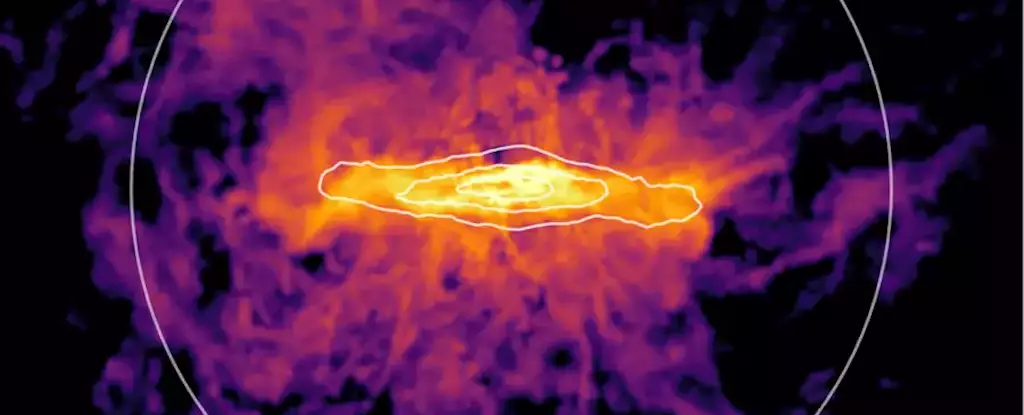In the cosmos, the materials that constitute our existence undergo incredible journeys that span light-years and eons. The phrase “we are made of star-stuff” resonates with many, made famous by the renowned astronomer Carl Sagan. However, the intricacies of how this elemental matter travels through the universe reveal a marvel far more grand than merely being born in the crucibles of stars. Recent observations from the Hubble Space Telescope have unveiled an extraordinary saga of carbon, the fundamental element that is an integral part of human life, and its surprising journey through the cosmos.
Carbon and other heavier elements trace their origins to the nuclear furnaces of stars, formed through a process of fusion and released into the universe upon the star’s cataclysmic death. As stars exhaust their nuclear fuel, their collapse leads to supernova explosions, scattering these elements throughout the interstellar medium. This material then feeds the formation of new stars and planets, creating a continuous cycle of cosmic recycling.
This process, however, has been enriched by new findings indicating that carbon can venture well beyond its originating galaxy before being pulled back in. Researchers have analyzed the circumgalactic medium (CGM) — an expansive halo of gas that envelops galaxies — and discovered that carbon can travel vast distances, potentially Hundreds of thousands of light-years from its home galaxy. This indicates a profound and complex network of exchange occurring between galaxies that challenges our existing notions of galactic evolution.
Unveiling the Circumgalactic Medium: A Cosmic Reservoir
Through extensive analysis of Hubble data, astronomers focused on 11 actively star-forming galaxies within the universe. Their findings demonstrated the presence of carbon extending as far as 391,000 light-years from its galaxy of origin. To provide perspective, the Milky Way galaxy itself has a diameter of approximately 100,000 light-years. The CGM functions metaphorically as a bustling cosmic transit hub, continuously propelling material outward while also drawing it back into the galaxy’s gravitational embrace.
Samantha Garza, the lead author of the study from the University of Washington, likened the CGM to a giant train station, where passengers (stellar materials) embark on journeys and return home. Such insights reveal a complex interplay between galaxies and their surrounding gas, suggesting that every element experiences unique patterns of movement driven by stellar life cycles.
The Chemical Signature: Analyzing Cosmic Interactions
The mechanism for detecting these cosmic movements involves examining how different elements absorb light at distinct wavelengths. The team utilized Hubble’s Cosmic Origins Spectrograph along with nine quasars as light sources for their analysis. The resulting spectral data provided a clear “fingerprint” of the carbon in the circumgalactic medium, indicating an astonishing minimum mass of carbon equivalent to about three million solar masses.
Previously, studies confirmed the presence of ionized elements like oxygen within the CGM of active galaxies. However, this research marks a milestone in identifying cooler elements like carbon as part of the cycling medium. This revelation unveils a more dynamic understanding of how the cosmos operates, particularly in relation to star-forming and passive galaxies, emphasizing that the active ones have a significantly greater reservoir of essential elements.
What does this mean for our understanding of galaxy formation and evolution? The CGM’s role as a massive storehouse for carbon and oxygen pushes scientific discourse further. The evidence bolsters theories that suggest active star-forming galaxies possess a more vigorous recycling process compared to those that are dormant. This dynamic exchange fosters ongoing star formation which is crucial for galactic life cycles.
As our own Milky Way continues to forge new stars, it becomes increasingly likely that the carbon and oxygen surrounding us have embarked on these celestial journeys. Understanding these cycles is crucial for comprehending how galaxies initiate and cease periods of star formation, shedding light on the cosmic mechanisms that govern the universe.
Ultimately, Carl Sagan’s words gain even deeper resonance when we consider the journey of the star-stuff that constitutes our bodies. Knowing that the carbon within us has traversed the vastness of space, potentially experiencing a galactic odyssey before contributing to our existence, evokes a sense of wonder. The interconnectedness of all matter in the cosmos reinforces our identity as products of not only our planet but of the universe itself.
The implications of studying the circumgalactic medium extend to significant cosmic events, including galactic mergers, potentially offering insights into the fate of the Milky Way in the future. As the fabric of the universe continues to expand and evolve, understanding the stories and journeys of carbon and other elements will enrich our appreciation for the grand narrative of existence, wherein the cosmos shapes us just as we seek to understand it.


Leave a Reply